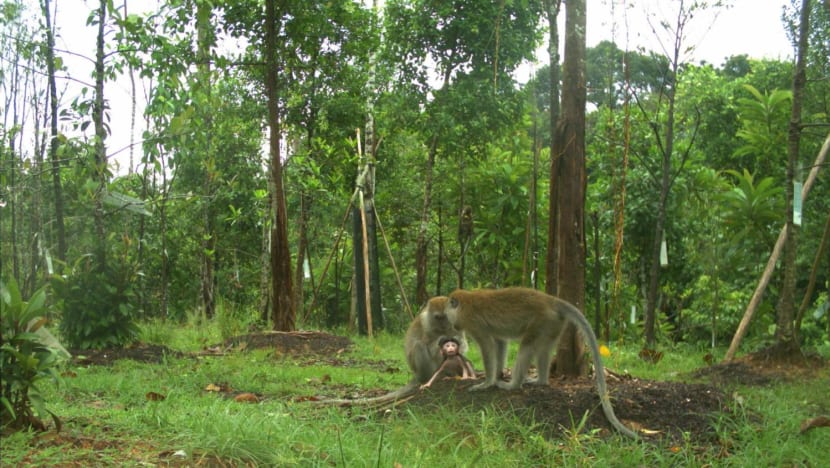Animal crossing: Sambar deer, wild pigs among dozens of species seen using Mandai Wildlife Bridge

A wild pig with piglets crossing the Mandai Wildlife Bridge. (Photo: Mandai Wildlife Group)
SINGAPORE: Male sambar deer sparring with their antlers locked against each other, and red junglefowl taking advantage of the upturned soil left by wild pigs digging for food.
These are just some of the animal interactions that have been recorded at Mandai Wildlife Bridge in the past 18 months.
Nearly 70 species of wildlife have been observed using and staying around the dedicated animal crossing since it opened in December 2019, Mandai Wildlife Group said on Thursday (Feb 3).
The bridge provides safe passage over Mandai Lake Road, which has seen roadkill including a pangolin and a leopard cat in the past.
Measuring between 35m to 44m wide at different points, the 140m long bridge has six cameras to track animal usage.

Since the bridge opened, sambar deer, long-tailed macaques and wild pigs have regularly been spotted on it, at times nursing and nurturing their offspring freely, said Mandai Wildlife Group.
Sambar deer, which are a globally vulnerable species, have been seen using the bridge at night on an almost daily basis, the group added.
Birds and bats are known to use the bridge as a crossing, and are at times observed foraging and nesting. Changeable hawk-eagles and monitor lizards have also been seen using the colugo poles on the bridge to perch and bask in the sun.
Besides these, the Sunda scops owl, common palm civet, large-tailed nightjar and lesser short-nosed fruit bat have also been seen using the crossing.



Mandai Wildlife Bridge connects two buffer zones in the Central Catchment Nature Reserve, each on one side of Mandai Lake Road.
"When the vegetation is mature, we expect that elusive species like the lesser mousedeer and Sunda pangolins will use the bridge to move between the forest patches," said Ms Chua Yen Kheng, Mandai Wildlife Group's assistant vice president of sustainable solutions.
Sightings and foraging activity of these two species have already been recorded near the bridge in the buffer zones of the Mandai development project, which are designed to minimise disturbance and increase the likelihood of shyer species using the bridge, said the group.

The vegetation there is on track to form a continuous canopy cover by 2025, said Mandai Wildlife Group.
Saplings of a locally threatened tree species – the Glochidion obscurum – have been found growing on the bridge as a result of animal dispersal, indicating the natural regeneration of flora on the structure, it added.
Aside from the cameras to track animal usage, fauna monitoring in the form of transect surveys form part of the long-term ecological monitoring programme at Mandai Wildlife Reserve, said the group.
The knowledge gathered is used to shape existing environmental management plans and assist in long-term planning for "ecological restoration, wildlife connectivity enhancement and population studies" for the precinct, it added.
Mandai Wildlife Bridge is part of the ongoing rejuvenation of Mandai precinct. The precinct will eventually house five wildlife attractions – the Singapore Zoo, Night Safari, River Wonders and the new Bird Paradise and Rainforest Wild – and a new eco-resort.














